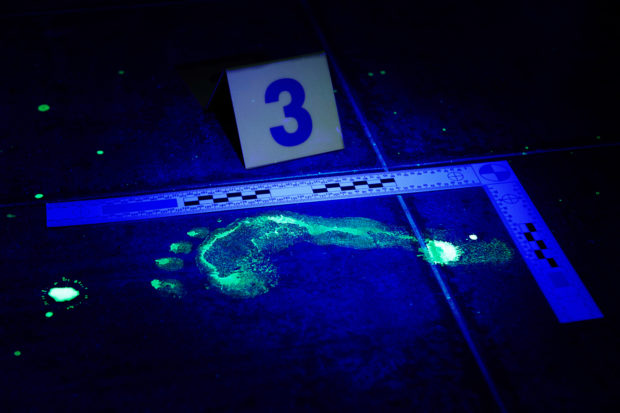How Luminol, The Blue-Glowing Crime Scene Chemical, Is Helping Investigators Illuminate Victims’ Stories

If you are a superfan of crime television shows such as Law & Order or Criminal Minds, then you might consider yourself a sort of crime scene investigation expert. But do you know the true science behind the famous luminol blood detection strategy?
If you are not sure what I’m talking about, let me paint the picture. Whenever investigators are stumped about what transpired at a crime scene, they often turn off all the lights and spray a chemical all over the room.
Then, the actors grab a black light and observe how any blood left behind starts to glow a blueish color.
That chemical is known as luminol. Chemically named C8H7N302, luminol is a compound that is able to produce a chemiluminescence reaction after coming into contact with blood.
Once sprayed, any luminol that touches the hemoglobin present in the blood will cause the area to glow.
Unlike in popular television, though, a black light is not necessary to observe the blue hues. The only thing that investigators need to detect this illuminated evidence is a dark room. And since 1937, this crime scene tool has forever changed police investigations.
Interestingly, though, scientists first synthesized luminol back in 1902. But, it was not until 1927 that a group of German scientists discovered the chemical’s luminescent properties.
And still, it took one more decade for Walter Specht– a German forensic scientist– to consider using this chemical for crime scene blood detection.
In 1937, Walter suspected that luminol would react to hemoglobin. So, he conducted an experiment wherein stone walls, bushes, furniture, and rusty fences were sprayed with blood.

Couperfield – stock.adobe.com – illustrative purpose only, not the actual person
Sign up for Chip Chick’s newsletter and get stories like this delivered to your inbox.
Then, Walter allowed the blood to dry and stain each surface for fourteen days before spraying a second solution containing luminol, sodium carbonate, and hydrogen peroxide on top.
He discovered that any areas with blood would become illuminated for about ten to fifteen minutes. And remarkably, luminol’s effects did not diminish the older a crime scene was.
Instead, Walter discovered that older blood stains would actually cause an even brighter and longer-lasting chemiluminescent reaction.
This scientific contribution was instrumental in helping crime scene investigators gain a second set of eyes. It is often difficult for authorities to spot blood spatter evidence when it is old or if perpetrators attempt to cover up their crimes.
However, if investigators are able to use luminol on the scene, the chemical can literally illuminate the events that occurred.
Like all things in life, though, luminol does have its downsides. First of all, modern luminol chemical compounds cause the blue glow to last for only about thirty seconds.
That means that investigators often reapply the solution in order to successfully study and photograph crime scenes.
Excessive reapplication, though, has been found to degrade blood samples– which can make confirmatory testing inconclusive or even impossible.
So, luminol is now used as a last resort when investigators are truly at a loss about what happened.
A second drawback involves luminol’s ability to react with other materials aside from blood– which can lead to “false positive” results at crime scenes.
Some examples of these materials include bleach, iron, and horseradish pulp.
And finally, the presence of a blueish glow cannot be the sole evidence investigators rely on to close a case.
What if someone stubbed their toe in the living room, was cooking a bloody steak in the kitchen, or nicked their face while shaving?
Other possibilities for why blood may be present must be taken into account, and luminol findings have to be corroborated against other evidence.
Despite these downsides, though, luminol is still a coveted tool by crime scene investigators that helps shine light upon victims’ stories. And without it, countless crimes over the past eighty-five years may not have been solved.
If true crime defines your free time, this is for you: join Chip Chick’s True Crime Tribe
Loaded Baked Potato Soup Is A Great Recipe To Try When The Temperature Starts To Really Drop
More About:True Crime